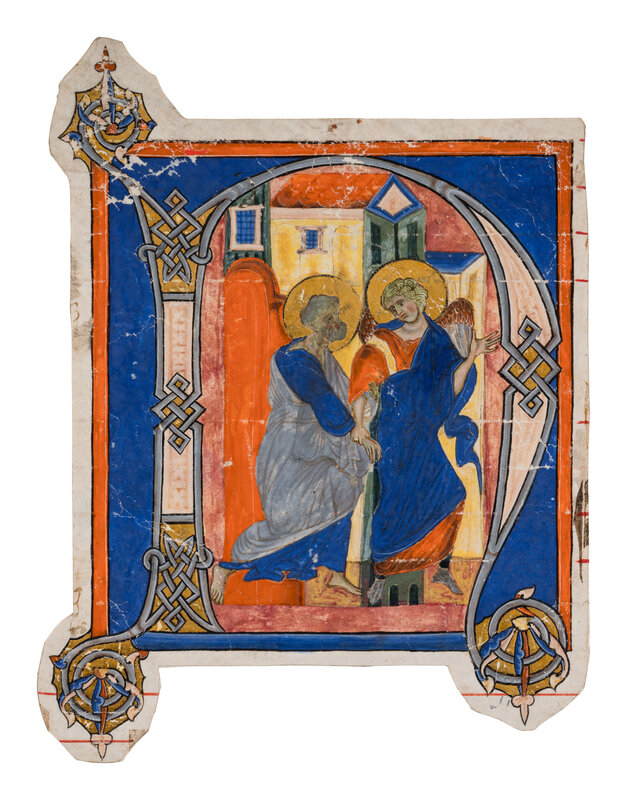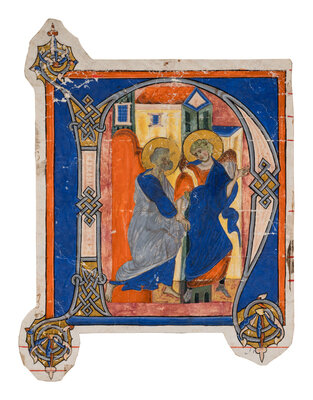Condition Report
Contact Information
Lot 8
ANONYMOUS VENETIAN ARTIST
Partial leaf from a Gradual, with a historiated initial ‘N’ of the Liberation of St. Peter, in Latin, illuminated manuscript on parchment [Italy, Venice, c. 1290-1300]
Partial leaf from a Gradual, with a historiated initial ‘N’ of the Liberation of St. Peter, in Latin, illuminated manuscript on parchment [Italy, Venice, c. 1290-1300]
Sale 2033 - Western Manuscripts and Miniatures
Jun 27, 2024
10:00AM CT
Live / Chicago
Own a similar item?
Estimate
$8,000 -
10,000
Lot Description
ANONYMOUS VENETIAN ARTIST
Partial leaf from a Gradual, with a historiated initial ‘N’ of the Liberation of St. Peter, in Latin, illuminated manuscript on parchment [Italy, Venice, c. 1290-1300]
Partial leaf from a Gradual, with a historiated initial ‘N’ of the Liberation of St. Peter, in Latin, illuminated manuscript on parchment [Italy, Venice, c. 1290-1300]
A strikingly large historiated initial depicting the Liberation of St. Peter, by an artist working in an early Gothic idiom related to the mosaics of San Marco in Venice.
216 x 158 mm. Partial leaf trimmed to the shape of the initial ‘N’, with two lines of text and musical notation remaining on the reverse, square notation on four-line staves in red (rastrum: 43 mm), ONE VERY LARGE HISTORIATED INITIAL in pink and grey on blue ground with orange border, with burnished gold highlights, the stems of the initial decorated with intricate geometric knots and terminated in spiraling tendrils (flaking in the colors and burnished gold, occasional stains, including one on the face of St. Peter, pasted on passe-partout with spots, else in good condition).
This initial ‘N’ comes from an unidentified Gradual, which could have contained the Proper of Saints and the Proper of Time. It introduced the Introit to the Mass for the feast of St. Peter and St. Paul (29 June), “N[unc scio vere, quia misit Dominus Angelum suum...].” The initial is modelled on the principles of older Romanesque illumination, yet betrays distinct artistic components connected to Venetian art of the last quarter of the thirteenth century. The shape of the letter is defined by greyish and light-blue tendrils acting as contours of the body, which sometimes compose complex knots of intertwined geometric patterns.
This principle, albeit in an essentially different form, recurs in miniatures associated with the Gaibana Master (see Padua, Biblioteca Capitolare, MS B2, Epistolario, 1259) and the illuminators of the early San Marco Choirbooks. This is best demonstrated upon comparison of this initial to the initial ‘B’ of a Bible illuminated in the 1260s by the workshop of the San Marco Choirbooks in Venice (Biblioteca Marciana, MS I.3, f. 26v) The relation to thirteenth-century illumination in the Veneto suggested by the conception of the initial should not, however, be interpreted as a workshop relationship, since the figural style of our master differs considerably from the art of both the Gaibana Master and the workshop of the San Marco choirbooks, and points to a later period. The architectural setting with various structures is of Byzantine descent.
The artist appears to have based some stylistic details, such as the hair of his apostles, with single locks rendered as abstracted rounded curls, on the mosaics of the southern wall of the northern atrium in San Marco, which depict Old Testament Scenes of Joseph. This affinity extends to the dynamic drapery, with numerous thin, parallel, and running folds, given as golden chrysograms in the case of the mosaics. On this basis, the miniatures should not be dated much earlier 1280, when the scenes of the San Marco mosaics were being completed. The facial features also offer some similarities with collaborators of Jacopino da Reggio, thus suggesting an awareness of Emilian late thirteenth- and fourteenth-century illumination. This is confirmed by the tendency of the gestures of the figures towards more dynamic attitudes, which may derive from Gothic models and synthesize different pictorial traditions. This ultimately hybrid style, associating many retrospective elements with more modern tendencies, might indicate that the illuminator of the present leaf worked not in Venice itself, but rather in the nearby regions of the Veneto.
Provenance
(1) Hargesheimer Kunstauktionen Düsseldorf, 21 March 2015, lot 26, acquired by:
(2) Robert McCarthy, London, MS BM 2473.
Sister leaves
Another initial ‘S’, also in the McCarthy collection (published together with the present one in his catalogue as no. 42, see below) might come from the same Gradual, as both are painted by the same hand in consistent style.
LITERATURE
The present leaf has been described and published in: Gaudenz Freuler and Georgi Parpulov, The McCarthy Collection, Vol. I, Italian and Byzantine Miniatures, London, 2018, no. 42b, pp. 136-7 (with further literature).
We are grateful to Gaudenz Freuler for permission to quote from his catalogue for this entry. Freeman’s | Hindman thank Senior Consultant Sandra Hindman and Elliott Adam for their assistance in preparing this sale.
The Collection of Robert McCarthy

